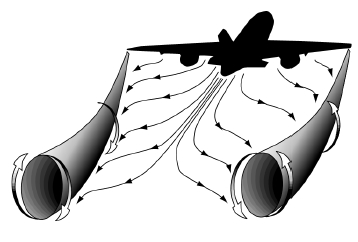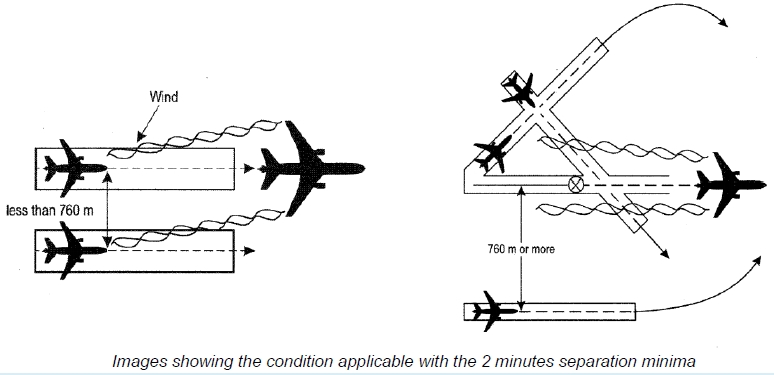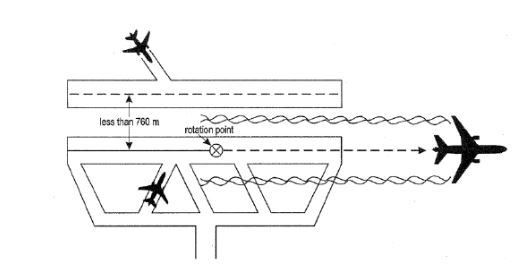¶ Definition
Wake turbulence is turbulence that forms behind an aircraft as it passes through the air, causing wingtip vortices.

¶ Radar wake turbulence separation minima
The following distance-based wake turbulence separation minima shall be applied to aircraft being provided with an ATS surveillance system (radar like IVAO ATC software) in the approach and departure phases of flight:
| Succeeding aircraft | behind | Preceding aircraft | Separation Minima |
|---|---|---|---|
| Light | behind | Medium | 5 NM |
| Heavy | Heavy | 4 NM | |
| Medium | Heavy | 5 NM | |
| Light | Heavy | 6 NM | |
| Heavy | A380 | 6 NM | |
| Medium | A380 | 7 NM | |
| Light | A380 | 8 NM |
These separation minima shall be applied when:
- An aircraft is operating directly behind another aircraft at the same altitude or less than 1000ft (300m) below.
- Both aircraft are using the same runway.
- Both aircraft are using parallel runways separated by less than 760m (2500ft).
- An aircraft crossing behind another aircraft, at the same altitude or less than 1000ft (300m) below.
Only air traffic control positions who can give air traffic control services using radar can define these minima. These minima are not applied for a tower controller for taking-off separation.
Note that in the IVAO network, IVAO ATC software will provide ATS surveillance system to all positions.
¶ Non-radar wake turbulence longitudinal separation minima
During non-radar en-route or arrival sequence and departure sequence of aircraft, an air traffic controller shall apply a minimum separation due to wake turbulence phenomena.
¶ Arriving aircraft
The following separation minima for arriving aircraft shall be applied by the air traffic controller:
| Succeeding aircraft | behind | Preceding aircraft | Arriving Separation Minima |
|---|---|---|---|
| Light | behind | Medium | 3 minutes |
| Medium | Heavy | 2 minutes | |
| Light | Heavy | 3 minutes | |
| Medium | A380 | 3 minutes | |
| Light | A380 | 4 minutes |

Note that all Boeings 757 which category is MEDIUM shall be considered as HEAVY as first aircraft.
An air traffic controller shall not be required to apply wake turbulence separation:
- For arriving VFR flights landing on the same runway as a preceding landing aircraft (heavy or medium)
- Between arriving IFR flights executing visual approach when the aircraft has reported the preceding aircraft in sight and has been instructed to follow and maintain own separation from that aircraft.
Note that in IVAO, a tower controller is not responsible of the wake turbulence for arrival separation. The approach controller is responsible of the separation during his approach sequence preparation.
The pilot-in-command shall be responsible for ensuring that the spacing from preceding aircraft of a heavier wake turbulence category is acceptable. If it is determined that additional spacing is required, the pilot shall inform the air traffic controller accordingly, stating their requirements.
¶ Departing aircraft general case
The following separation minima for departing aircraft shall be applied by the air traffic controller:
| Succeeding aircraft | behind | Preceding aircraft | Departing Separation Minima |
|---|---|---|---|
| Light | behind | Medium | 2 minutes |
| Medium | Heavy | 2 minutes | |
| Light | Heavy | 2 minutes | |
| Medium | A380 | 3 minutes | |
| Light | A380 | 3 minutes |

These separation minima shall be applied only when aircraft are using:
- The same runway
- Parallel runways separated by less than 760m (2500ft)
- Crossing runway if the projected flight path of the second aircraft will cross the projected flight path of the first aircraft at the same altitude or less than 1000ft (300m) below.
- Parallel runways separated by 760m (2500ft) or more, if the projected flight path of the second aircraft will cross the projected flight path of the first aircraft at the same altitude or less than 300m (1000ft) below.

Note that all Boeings 757 which category is MEDIUM shall be considered as HEAVY as first aircraft.
¶ Departing aircraft from an intermediate part of the runway
If the second aircraft will take off from an intermediate part or the same runway or a parallel runway by less than 760m (2500ft), the separation minima time shall be extended.
| Succeeding aircraft | behind | Preceding aircraft | Departing Separation Minima |
|---|---|---|---|
| Light | behind | Medium | 3 minutes |
| Medium | Heavy | 3 minutes | |
| Light | Heavy | 3 minutes | |
| Medium | A380 | 4 minutes | |
| Light | A380 | 4 minutes |

¶ Displaced landing threshold
A separation minimum shall be applied between a MEDIUM or LIGHT departing aircraft behind a HEAVY arriving aircraft when operating on a runway with a displaced landing threshold:
| Departing aircraft | behind | Arriving aircraft | Departing Separation Minima |
|---|---|---|---|
| Light | behind | Medium | 2 minutes |
| Light | Heavy | 2 minutes | |
| Medium | Heavy | 2 minutes |
A separation minimum shall be applied between a MEDIUM or LIGHT arriving aircraft behind a HEAVY departing aircraft when operating on a runway with a displaced landing threshold:
| Arriving aircraft | behind | Departing aircraft | Departing Separation Minima |
|---|---|---|---|
| Light | behind | Medium | 2 minutes |
| Light | Heavy | 2 minutes | |
| Medium | Heavy | 2 minutes |
¶ Departing aircraft from opposite direction
Sometimes due to local regulations and geographical constraints the runway must be used in an opposite-direction runway take-off.
A separation minimum of 2 minutes shall be applied between a LIGHT or MEDIUM aircraft and a HEAVY aircraft and between a LIGHT aircraft and a MEDIUM aircraft when the heavier is making a low or missed approach and the lighter aircraft is:
- Utilizing an opposite direction runway for take-off
- Landing on the same runway in the opposite direction
- Landing on a parallel opposite direction runway separated by less than 760m(2500ft)
- none
- ICAO Documentation 4444 - Air Traffic Management - 16th Edition 2016 - Chapter 5.8
- ICAO Documentation 4444 - Air Traffic Management - 16th Edition 2016 - Chapter 8.7
- VID 150259 - Author
- VID 531824 - Wiki integration
- VID 496402 - Wiki.js integration